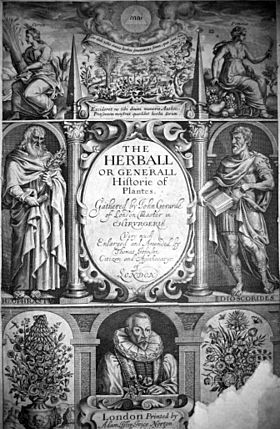Thomas Johnson (botanist) facts for kids
Quick facts for kids
Thomas Johnson
|
|
|---|---|

Title page of Johnson's 1633 edition of Gerard's Herball
|
|
| Born | 1595–1600 Selby, Yorkshire, England |
| Died | 1644 Hampshire |
| Occupation | apothecary, botanist |
| Nationality | English |
| Notable works | John Gerard's Herball, expanded |
Thomas Johnson (died 1644) was an English botanist, and a royalist colonel in the English Civil War. He has been called the "father of British field botany".
Life
Johnson was born at Selby in Yorkshire between 1595 and 1600. He seems to have received a good education, and to have become an apothecary in London by 1626. Possibly before that he was living in Lincolnshire (Gerard, Herball, ed. 1633, p. 74). In 1629 he was in business on Snow Hill, city of London, where he had a physic-garden, and had become a prominent member of the Apothecaries' Company.
On the outbreak of the civil war Johnson joined the royalists, and, partly for his learning, partly no doubt for his loyalty, was made a Bachelor of physic by the University of Oxford in 1642, and M.D. on 9 May 1643. Johnson took an active part in the defence of Basing House, becoming lieutenant-colonel to Sir Marmaduke Rawdon, the governor, and on 14 September 1644, during a skirmish with a detachment of Sir William Waller's troops under Colonel Richard Norton, he received a shot in the shoulder, "whereby contracting a feaver, he died a fortnight after" (Siege of Basing Castle, 1644).
Work
His first work was a short account of one of the herborising excursions which the company was in the habit of undertaking. This, the first local catalogue of plants published in England, was entitled "Iter Plantarum Investigationis ergo susceptum a decem Sociis in Agrum Cantianum, anno Dom. 1629, Julii 13" (London, 1629), and an appendix of three pages is headed "Ericetum Hamstedianum seu Plantarum ibi crescentium observatio habita anno eodem 1 Augusti." Johnson seems (Herball, p. 450) to have been in Kent in 1626, and to have revisited both that county and Hampstead Heath, as in 1632 he published an enlarged edition of both lists. The plants are named in them according to Lobel, Dodoens, and Gerard. Anna Pavord provides an account of this expedition in her book, The Naming of Names following Gilmour's translation (Gilmour 1972), stating that he was inspired in his explorations by one of the first descriptions of botanical exploration, that of Ulisse Aldrovandi (1557).
In 1633 Johnson published his most important work, The Herball, … gathered by John Gerarde, … very much enlarged and amended by Thomas Johnson, citizen and apothecary of London. So great had been the progress of botany in the thirty-six years since John Gerard's original publication (1597), that Johnson added over eight hundred new species to the list, and seven hundred figures, besides numerous corrections. The work, which contains about 2,850 descriptions, is commonly known by the name "Gerard emaculatus", given to it by Ray. Johnson seems, however, to have completed it in a year. It was reprinted in 1636 without alteration. Haller styles it "dignum opus, et totius rei herbariæ eo ævo notæ compendium".
In 1634 Johnson published Mercurius Botanicus; sive Plantarum gratia suscepti itineris, anno 1634, descriptio, a description, in seventy-eight pages, of a twelve-day tour to Oxford, Bath, Bristol, Southampton, and the Isle of Wight, with English and Latin names of the plants observed. To this was added De Thermis Bathonicis … Tractatus, pp. 19, with plans of the baths. In 1641 he issued Mercurii Bot. pars altera, describing a visit to Wales and Snowdon, and the discovery of many new plants. In 1643 he published a translation of the surgical works of Ambroise Paré from the French, which was reprinted in 1678.
Legacy
Wood speaks of him as "the best herbalist of his age in England," and as "no less eminent in the garrison for his valour and conduct as a soldier." The minor botanical works of Johnson, which became very scarce, were collected and edited by T. S. Ralph in 1847, under the title of Opuscula omnia botanica Thomæ Johnsoni. Genera dedicated to his memory by Miller and by Adanson having become merged in the genera Callicarpa and Cedrela respectively, the name Johnsonia now belongs to a genus of Xanthorrhoeaceae named by Robert Brown.

